It’s been a long time since Dillon Precision has introduced a new reloading press. Dillon Precision has taken the strategy to introduce products only when there’s really something new to bring to the market. And this is consistent with how I describe Dillon Precision products: “Tried and True”. So when I heard that Dillon had introduced the new XL-750 5-station progressive reloading press (an improved version of the XL-650) I thought to myself: “This will be interesting”. And interesting it is indeed! In this article/video I’ll go in-depth on this new press- including unboxing (press and case feeder), setup, loading pistol, caliber changeover (all steps), loading pistol, total cost of ownership, and pros/cons. Buckle up!
What’s In the Box (XL-750 Press)
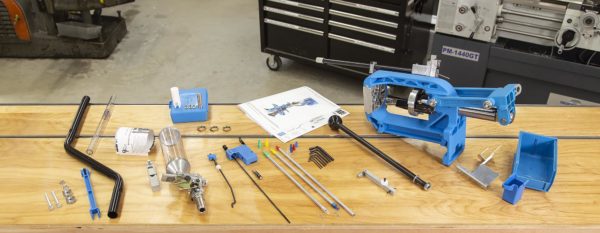
The XL-750 press kit comes with everything you need to load a particular caliber with the exception of dies and consumables/accessories. In the picture above we have the box contents for the XL-750 (223 caliber option shown, from left to right):
- Case feed components: support bar, stand-off bracket (blue), drop tube, mounting hardware
- Powder measure with both pistol and rifle slide bars + fail-safe rod (return rod)
- Caliber changeover parts box, caliber-specific parts
- Low primer warning system with AAA battery
- Owner’s manual and quick start guide booklet (top)
- Primer pick-up tubes (large + small), primer tube (size not installed in press), extra tube ends
- Allen key set
- Press handle
- Primer slider (press comes with both large and small sliders, one installed in press)
- Press assembly
- Completed cartridge discharge chute
- Spent primer catcher
- Completed cartridge bin
In addition to the components supplied for loading a specific cartridge, the press comes with everything you’ll need to change from large to small primers as well as pistol + rifle powder measure configurations.
What’s In the Box (XL-650/XL-750 Case Feeder)
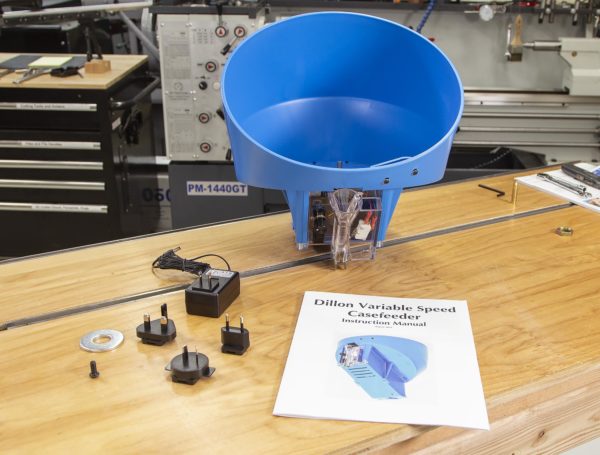
The XL-650 / XL-750 case feed kit comes with everything needed to automate case feeding for your XL-650 or XL-750 press, including one case feed plate (not shown above). You can also purchase the case feeder without a case feed plate if you already have the feed plates you need.
Box contents:
- Motorized case feeder assembly
- 120V/240V multi-voltage power adapter and plug adapters for most international regions
- Spacer washer (used for some specific case lengths under case feed plate)
- Mounting screw
- Instruction booklet
Setting Up the Press and Case Feeder
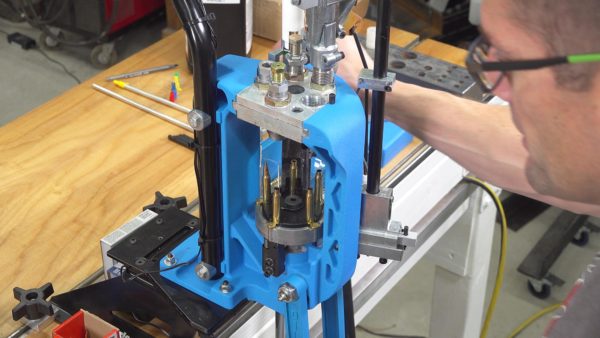
The XL-750 comes out of the box “mostly assembled”. You’ll need to mount the press and then finish putting things together in order to start loading ammunition.
Here’s a couple guides I put together outlining everything needed to load either pistol or rifle ammunition. If you haven’t loaded either pistol ammo or rifle ammo, these articles are worth a read:
What you need to load pistol ammunition
What you need to load rifle ammunition
As outlined in the video, you’ll need to complete the following steps to prepare for loading:
- Mount the press using the press frame holes (1/4″ x 20 bolts), or a press mount such as Dillon’s Strong Mount or Inline Fabrication’s Ultramount
- Bolt the case feed support bar to the press frame (using supplied hardware)
- Install case drop tube support bracket (if not installing powered case feeder)
- Install case drop tube block and drop tube
- Install press handle
- Install powder die in toolhead
- Drop in powder funnel (combo funnel/expander for pistol)
- Install powder measure on powder die, install fail-safe rod
- Install battery in low primer warning buzzer, install buzzer on primer shield cap
- Install and adjust dies
- Optional: Install and adjust powder check system
- Optional: Install case feed bowl and case feed plate, adjust feed plate clutch if needed
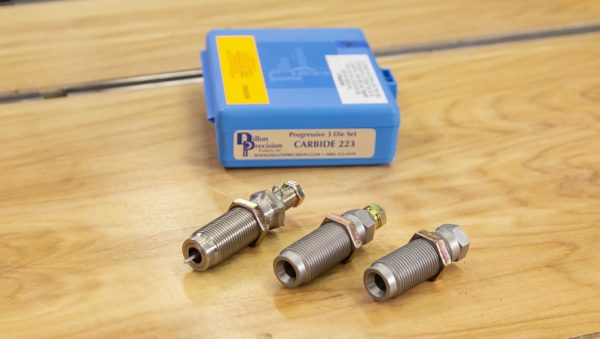
Above: Dillon Carbide 223 three die set was used for this reloading setup, an outstanding die set for volume loading 223.
Loading 223 on the XL-750
The XL-750 is a GREAT option for volume loading 223! For this loading setup, I used the following equipment setup:
- Dillon XL-750 with Case feeder
- Small rifle case feed plate
- Rifle powder bar in powder measure
- Dillon Dillon Carbide 223 three die set (see below for station utilization)
And here’s how the stations were setup on the XL-750 for 223:
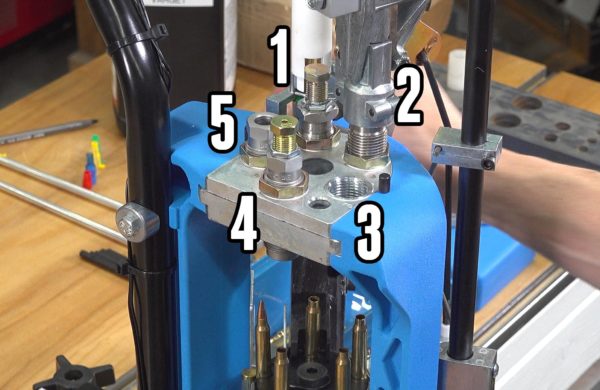
Above we have:
- Sizing/de-priming
- Priming (bottom of stroke), powder charge (top of stroke)
- Empty (placeholder for Dillon powder check system)
- Bullet seating
- Crimp
This setup worked 100% with no malfunctions once I tweaked a few things:
- I slightly bent the case retention wire at station #2 towards the center of the shellplate
- I installed a spring on the primer slider that helps keep the plastic pulley away from the bar (a viewer told me about this!)
This was my first test-drive of the new priming system on the XL-750 (biggest change over the XL-650). In short: I LOVE it. Very smooth, on-demand, excellent feel (bottom of stroke), and 100% reliable with the tweaks listed above.
Caliber Changeover (Complete)
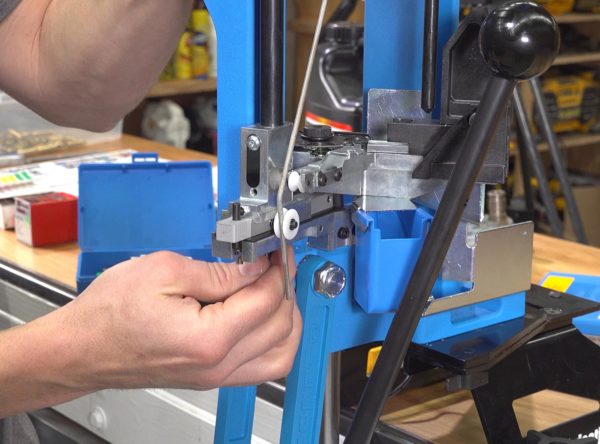
When you go to change over calibers, there are multiple variables what will dictate how long it will take, and how many steps you’ll have to complete including:
- Whether there is a primer size change
- Whether there is a powder bar change (rifle to pistol or vice-versa)
- How much “dedicated equipment” you have (example: dedicated toolhead with powder measure)
Here’s the complete list of caliber changes (assuming dedicated toolheads used)
- Remove fail-safe rod and powder measure
- Remove toolhead pins and slide out toolhead
- Slide in new toolhead, replace pins
- Remove locator buttons, ejector wire, loosen hold-down bolt allen screw, remove hold-down nut, shellplate, and case slider plate
- Replace new case slider plate, shellplate, hold-down bolt, tighten hold-down bolt allen screw, install ejector wire, install locator buttons
- Change over primer system (slider, primer tube) *Only if primer size is different
- Change over powder measure bar *Only if changing from rifle to pistol of vice versa)
- Change over case feeder small parts including case feed plate *Case feed plate change only needed in some cases
Additional notes:
- Some cartridges (Example: 6.5 Creedmoor and 308 Winchester) will share some caliber changeover parts (including shellplate + case feed parts)
If you are “in practice”, the caliber changeover (worst case) should take 10-15 minutes at worst assuming you’ve emptied your primers, powder, and cases from the case feeder. Best case you can do a caliber changeover (including toolhead) in about 5 minutes.
Loading 45 ACP on the XL-750
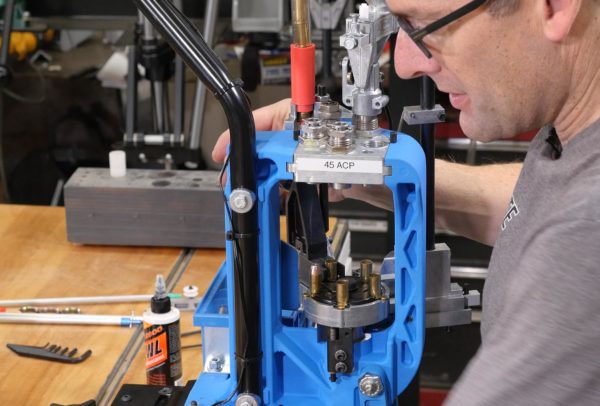
Just like with 223, loading 45 ACP on the Dillon XL-750 was exceptionally smooth and pleasant! Loading 45 ACP was also 100% functioning once I got things “dialed in”. For 45 ACP, I crushed the tops of a couple of Hornady 230 grain 45 caliber bullets due to tipping. After a quick inspection I noticed that I had insufficient case mount expansion. So I lowered the powder die (and drop funnel expander) to increase the case mount expansion. This totally resolve the issue: standard press setup process.
Here’s the station utilization for 45 ACP on the XL-750:
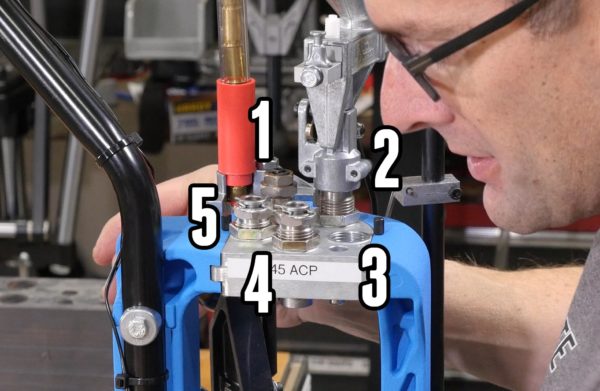
Above we have:
- Sizing/de-priming
- Priming (bottom of stroke), powder charge and case mouth expansion (top of stroke)
- Empty (placeholder for Dillon powder check system)
- Bullet seating
- Crimp
The next things I’d like to look at for both the 223 loading setup and the 45 ACP loading setup would be to add the powder check system and a bullet feeder setup. That would take this press to the next level!
XL-750 Total Cost of Ownership
Buying a reloading press is a bit like buying a car: you want to make sure you fully understand the “total cost of ownership” before laying down your money! A bit of a cost-benefit analysis. With reloading press systems there can be surprises (such as presses that don’t come with everything for large/small primers or rifle/pistol powder measure setups.
Here’s the numbers for a few setups including a single caliber, two calibers, and four calibers.
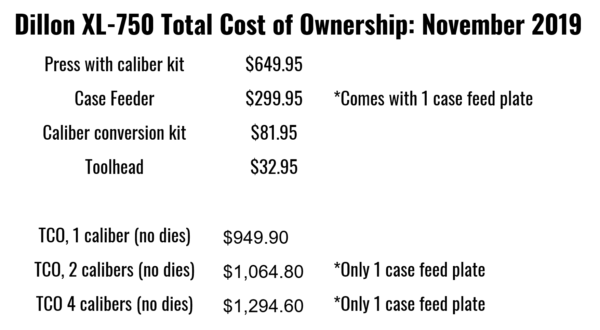
For the figures above, you’ll need to add or subtract the following:
- Case feed plates (small pistol, large pistol, small rifle, large rifle) may be needed
- Some caliber conversion kits may be shared (Examples: 308/6.5 Creedmoor and 357 Magnum/38 Special)
- Dies can vary widely in price and quality
- Some extras (like dedicated powder measures) can greatly simplify caliber changeovers
For each new caliber you add, you’ll want the following (in some cases caliber changeover parts can be shared between calibers):
Considering the quality of the XL-750 and the reliable/smooth functioning, I believe the XL-750 system represents a VERY solid value.
XL-750 Pros/Cons
There is no one reloading press system that can “optimize everything”, and no single company can patent all of the good ideas. It’s therefore necessary to pick a system based on the “Best overall value and features” for you and your needs! Here are some pros and cons for the XL-750 system that should be helpful. These insights are provided based on my intimate knowledge of most reloading presses on the market today.
XL-750 Pros:
- Quality, fit and finish
- Made in USA
- Reliable and smooth functioning
- Best-in-class case feeder
- Much-improved priming system
XL-750 Cons:
- Cost: this system costs more than some others, including caliber change over total kit cost
- Tool Head design doesn’t permit quick single die removal/replacement (Examples: lockout die fix or powder measure dump)
Conclusion
I really like the XL-750! Dillon is conservative about launching new products- and that’s a good thing when you want something that’s been well engineered and tested. Since it’s compatible with the XL-650 caliber changeover parts, it makes a great upgrade from the XL-650 or 2nd press next to an XL-650.
If you want your own XL-750, you can get from multiple vendors (and perhaps your local shop), but you can also order directly from Dillon Precision’s Website.
I’ll be posing a story outlining all of the differences between the XL-650 and XL-750 presses, you’ll want to check that out!
What do you think of the new Dillon XL-750? Please drop a comment!
Don’t miss out on Ultimate Reloader updates, make sure you’re subscribed!
Thanks,
Gavin
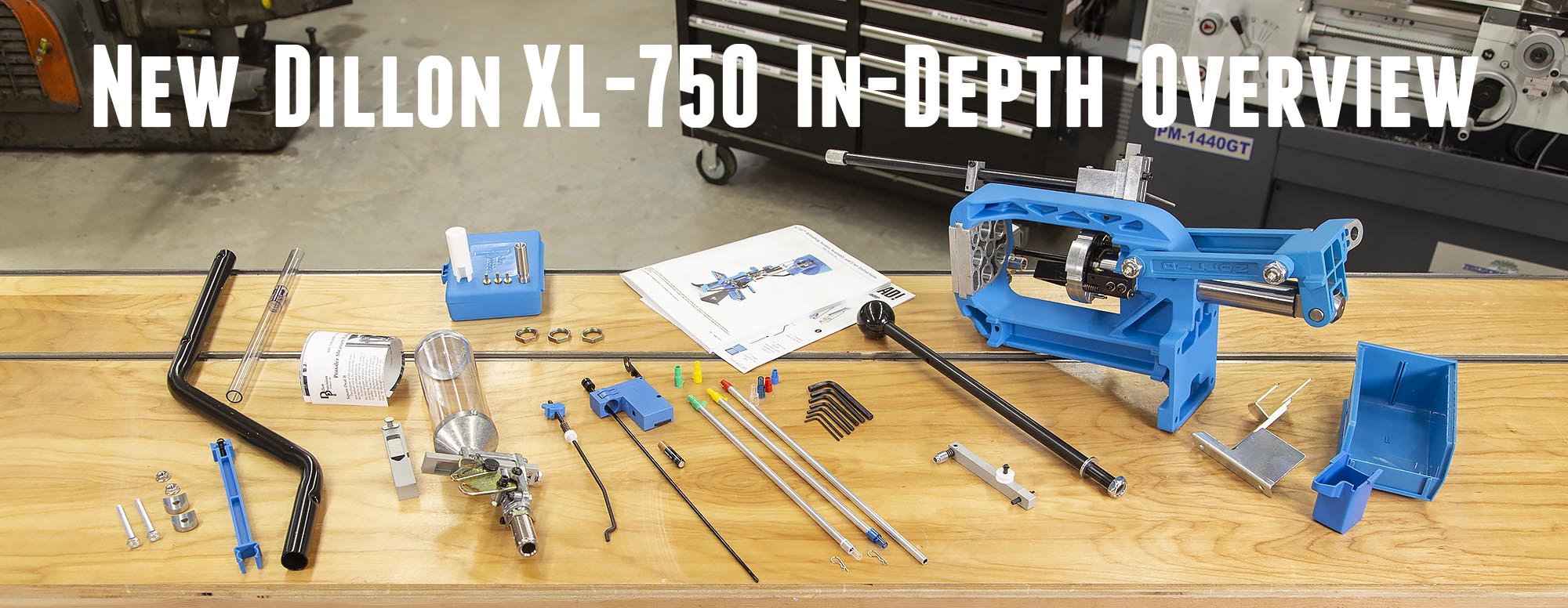


















































































I plan on buying a XL 750 just trying to figure out what all i will need to all the calibers i plane on reloading .45 .9MM .270
223/.556 .308. Hope to order before the first of the year!!! Thanks for the video like watching all of them. Nice place you have in the North West!!!!
There’s a handy little windows program available at http://www.nfatoys.com/dillon/ that has just about every available caliber for the XL650 in it and allows you to cross-check what parts are compatible across different conversion kits. I’ve found a few newer calibers aren’t in there, but you can also edit/add new ones if you get all the right data (for instance, 6.5 CM isn’t in there, but you can “build” the appropriate data into the app with a quick call to Dillon to get the appropriate part numbers).
A good rule of thumb on the caliber conversions – if you need a new shell plate for the new caliber, then you’re likely best off to get the whole conversion kit. In your example, here’s what I’m seeing:
.270 and .308 use the same shellplate, locator pins, station 1 locator, casefeed adapter, arm bushing, body bushing, AND casefeed disc (so the only thing not the same is the powder funnel). To set up your XL750 (or 650) for those two calibers, just buy the conversion kit for one of them (either one), and then buy the powder funnel for the added caliber.
45 ACP also uses the same shellplate, locator pins, station 1 locator, and body bushing, so to add 45 ACP to the above you would need to buy the appropriate powder funnel, casefeed adapter, arm bushing, and casefeed plate.
9MM and 223/556 don’t share any major components with the above calibers, so for those you’re best off just buying a full caliber conversion. It also seems that the 9mm and 223 configured units are the most common in stock most places, so if you start with one of them (say 9mm), add the 308 caliber conversion and 223 conversion, and then the misc parts (funnels, case feed plates, etc.) for the rest of your calibers, you’ll be in good shape.
Of course, you’ll need dies, tool heads, and all the rest to go with it. But at least for caliber conversions, that will get you started.
After loading hundreds of thousands of rounds on SDB, 550, 650 and 900 Dillon reloaders I think I’m qualified to ask a simple question…Why the change from a 650 to the 750?
Is there something that someone us not telling us about the 650’s rotary primer system that we should know???
I have a Hornady Iron (influenced by some of your earlier videos) single stage press and I would eventually like to add an XL750 to the bench. It is apparent that something such as the Lock-and-Load connection for the powder feed would be handy until dedicated plates could be setup.
Could you talk a bit about integrating this with a single stage such as Hornady. What parts would work on the Dillon.
Another significant thing I see is many people de-prime then tumble, and cartridge length checks are made after sizing. Do you do a length check gefore sizing and call it good?
Thanks
Dave W.
Excellent video as usual. Do you have any issues with sideways primers on either the 650 or 750? Seems I get a couple pressed in sideways every so often on my 650.
Traditional (RCBS) bullet feeders are no longer possible to use in Station 4 on the 750 because of the new primer config, which in turn affected the powder measure/failsafe position, which affects the powder bar position, which now resides directly over Station 4 – especially with a micrometer powder bar. The height of a Redding Competition seating die will be okay, but the bullet feeder tube/springs is way too high and simply can no longer be used in Station 4.
I started with a 550 with the same primer system as the 750. That priming section was one of the reasons I went to the 650. I just never liked the way the shuttle worked. As soon as the non-stick coating wears off you have to call Dillon for free replacements because without that slick coating, it just won’t function.
I’ve had a 750 for a couple of months now, and I gotta say, “Where has this machine been all my life?!” I’m 100% thrilled with it. Upgraded from a decades-old, very well used 550B; I’ve loaded about 1000 rounds of .45 acp and approx 200 rds of .308. I couldn’t be happier with it.
I have loaded a lot on single stage, quit a bit on a 550, and just added a 750 to my collection, I did not add the 750 for speed, (however, it is nice). I am a OCD type of person, and wanted the powder check die. It simply adds another safety check. It will save you a empty case, or a double charged case when things go south, and they will go south sometime. After a little tweaking of the primer system, which is just like the 550, the press ran flawlessly. Once you get used to the fact that there is no backing up, it is a breeze, and joy to run. With a little bit of mechanical knowledge, anybody can produce very quality ammo. The 750 is not intended for precision rifle ammo, due to the fact that the case indexes from the shell plate instead of the main platform. Don’t sell your single stage, or the 550, they are still necessary. In summary, after about 2500 rounds of 9mm and 45acp, I highly recommend the Dillon XL 750 with case feeder. Save your nickels, and take the plunge, you will not be sorry!!!
Thanks for the review of the XL750, I own a XL650, so I’m looking forward to your 650/750 comparison. The primer system on my 650 does have a bit of room for improvement, but it could be the operator may need a bit of improving also.
Thank You Gavin for all you do here. The information you present is invaluable. I have learned so much and made good purchasing decisions because of it. I have owned a Dillon XL650 for about 4 years now and love it. After owning several other manufactures progressive presses Dillon’s are the only ones that are really worth the money. As you mentioned the con is Dillon’s are expensive but from a real world functioning perspective they really are worth the money. The biggest challenge in progressive presses is the primer feeding system and turret timing. Every other manufacture I tried except the XL650 jams, flips, crushes, feeds sideways the primers frequently. Becomes out of time frequently and jams. The reason we buy progress is to load volume quickly but with the others you’ll spend more time redoing loads and un-jamming the system than loading. My recommendation is spend the extra money and have a headache free system. I would highly recommend purchasing the auto case-feeder, roller handle, strong mount, bullet tray, powder check die, and extra primer pickup tubes.
I own both the XL 650 and XL 750. I had many upgrades to the 650 such as primer stop, case feed stop, roller on cam pin, brass washer and ball and spring on shell plate, live primer bottle to catch primers, spent primer recover system, roller below the platform as on the 750 ETC. The 650 was a great Reloader. Once I figured out the problems with the 750 it’s a great machine also.
I’m wanting to get a750 to replace 2 lock n load Hornady’s case feeder problems drive me nuts. Is xl 750 that much better to warrant expenses, I’ve got a lot of parts,shell plates ect.
The ‘Total Cost of Ownership’ for one caliber lists the tool head as an additional item/expense.
Does the $649 press not come with a tool head already?
Also, if one orders a 750 and selects “.223 Rem” from the drop down… and orders a case feeder, set up for “small rifle”… what exactly does the caliber conversion kit provide that isn’t already included with the press as ordered?
Hi Monte- good to hear from you!
The press does come with a toolhead (so for 1 cal, I didn’t add that for TCO). If you order the case feeder, it comes with one case feed plate which you specify!
Hello,
Did you post specifics on the wire you bent to turn off case feed? I apologize if I missed it.
Also, do you have information regarding the spring that you installed on the primer slider?
Thanks
I’m looking at the XL750, to replace my old Lyman press that’s is over 20yrs old. Wondering if I can use my lyman dies an Lee dies in it?